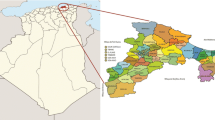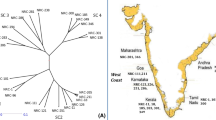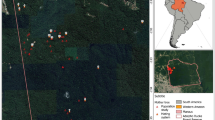Abstract
Camellia oleifera Abel. is an important economic tree species of southern China. In this study, we evaluated the mating system and genetic diversity of a series of cultivars of C. oleifera ‘Ruan Zhi’. A total of 159 individuals from the progenies of four cultivars were tested by simple sequence repeat molecular markers. Results reveal that 11 pairs of primers showed polymorphism and their polymorphism information content value was greater than 0.73, suggesting that these primers could be used to identify the genetic diversity of open-pollinated populations. The average number of effective alleles (Ne = 4.88) was significantly different from the average number of alleles (Na = 12.18), and their distribution in the sample population was not uniform. The average observed heterozygosity (Ho = 0.96) was greater than the average expected heterozygosity (He = 0.79), and the population heterozygote was excessive. Shannon index was 1.84 and populations showed high genetic diversity. As regards to the mating system, the multilocus outcrossing rate was 0.996, and the single locus 0.866. These results indicate a high degree of outcrossing by C. oleifera ‘Ruan Zhi’. We recommend selecting individuals for high genetic gain from the progenies of cultivars because of outcrossing characteristics and genetic diversity for application to germplasm conservation and promotion.
Similar content being viewed by others
References
Breed MF, Ottewell KM, Gardner MG, Marklund MHK, Stead MG, Harris JBC, Lowe AJ (2012) Mating system and early viability resistance to habitat fragmentation in a bird-pollinated eucalypt. Heredity 115(2):100–107
Chiari L, Resende RMS, Matida ET (2010) Mating system parameters in Stylosanthes guianensis (Aubl.) Sw. based on RAPD markers. Afr J Biotech 9(36):5820–5822
Deng XL, Xie GS (2008) Development of refining squeezing tea oil. Chem Bioeng 01:46–48
Funda T, Chen CC, Liewlaksaneeyanawin C, Kenawy AMA, Elkassaby YA (2008) Pedigree and mating system analyses in a western larch (Larix occidentalis nutt.) experimental population. Ann For Sci 65(7):705
Gaiotto FA, Grattapaglia D, Vencovsky R (2003) Genetic structure, mating system, and long-distance gene flow in heart of palm (Euterpe edulis Mart.). J Hered 94(5):399
Gao C, Yuan DY, Yang Y, Wang BF, Liu DM, Zou F, Tan XF (2015) Anatomical characteristics of self-incompatibility in Camellia oleifera. Scientia Silvae Sinicae 51(02):60–68
Geng QF, Lian CL, Goto S, Tao JM, Kimura M, Islam MS, Hogetsu T (2010) Mating system, pollen and propagule dispersal, and spatial genetic structure in a high-density population of the mangrove tree Kandelia candel. Mol Ecol 17(21):4724–4739
Han YC, Teng CZ, Wahiti GR, Zhou MQ, Hu ZL, Song YC (2009) Mating system and genetic diversity in natural populations of Nelumbo nucifera (nelumbonaceae) detected by ISSR markers. Plant Syst Evol 277(1/2):13–20
Hedrick PW, Garcia-Dorado A (2016) Understanding inbreeding depression, purging, and genetic rescue. Trends Ecol Evol 31(12):520–940
Islam MS, Lian C, Kameyama N, Hogetsu T (2015) Analysis of the mating system, reproductive characteristics, and spatial genetic structure in a natural mangrove tree (Bruguiera gymnorrhiza) population at its northern biogeographic limit in the southern Japanese archipelago. J For Res 20(2):293–300
Jia BG, Lin Q, Feng YZ, Hu XY, Tan XF, Shao FG, Zhang L (2015) Development and cross-species transferability of unigene-derived microsatellite markers in an edible oil woody plant, Camellia oleifera (theaceae). Genet Mol Res 14(2):6906–6916
Kang M, Huang HW (2005) Genetic Diversity in Fragmented Populations of Berchemiella wilsonii var. pubipetiolata (Rhamnaceae). Ann Bot 95(7):1145–1151
Luijten SH, Dierick A, Gerard J, Oostermeijer B (2000) Population size, genetic variation, and reproductive success in a rapidly declining, self-incompatible perennial (Arnica montana) in the netherlands. Conserv Biol 14(6):1776–1787
Mandal AK, Ennos RA (1995) Mating system analysis in a natural population of Acacia nilotica, subspecies kraussiana. For Ecol Manag 79(79):235–240
Moriguchi Y, Tani N, Itoo S, Kanehira F, Tanaka K, Yomogida H, Taira H, Tsumura Y (2005) Gene flow and mating system in five Cryptomeria japonica D. don seed orchards as revealed by analysis of microsatellite markers. Tree Genet Genomes 1(4):174–183
Muluvi GM, Sprent JI, Odee D, Powell W (2004) Estimates of outcrossing rates in Moringa oleifera using amplified fragment length polymorphism (AFLP). Afr J Biotech 3(2):146–151
Muoki RC, Wachira FN, Pathak RS, Kamunya SM (2007) Assessment of the mating system of Camellia sinensis in biclonal seed orchards based on PCR markers. J Pomol Hortic Sci 82(5):733–738
Rasmussen KK, Kollmann J (2008) Low genetic diversity in small peripheral populations of a rare european tree (Sorbus torminalis) dominated by clonal reproduction. Conserv Genet 9(6):1533–1539
Ritland K (1989) Correlated matings in the partial selfer mimulus guttatus. Evolution 43(4):848–859
Ritland K (2002) Extensions of models for the estimation of mating systems using n independent loci. Heredity 88(4):221–228
Sheridan PM, Karowe DN (2000) Inbreeding, outbreeding, and heterosis in the yellow pitcher plant, Sarracenia flava (sarraceniaceae), Virginia. Am J Bot 87(11):1628–1633
Stoeckel S, Grange J, Fernándezmanjarres JF, Bilger I, Frascarialacoste N, Mariette S (2006) Heterozygote excess in a self-incompatible and partially clonal forest tree species—Prunus avium L. Mol Ecol 15(8):2109–2118
Valdez-Ojeda R, Quiros CF, Aguilar-Espinosa MDL, Rivera-Madrid R (2010) Outcrossing rates in annatto determined by sequence-related amplified polymorphism. Agron J 102(5):1340
Wang C (1999) Plant mating system and its evolutionary mechanism in relation to population adaptation. J Wuhan Bot Res 11(9):e0162401
Wang HX, Hu ZA (1996) Plant breeding system, genetic structure and conservation of genetic diversity. Chin Biodivers 2:92–96
Wang WJ, Chen CG, Cheng J (2007) The medicine’s active role of Tea oil in health care. Food Nutr China 9:48–51
Wang DX, Zeng WJ, Jiang ZP, Wu YM, Zhang NY (2014) Genetic variation and correlation of soft-branch Camellia oleifera fruit’s characters in Cenxi. J Northwest For Univ 29(06):85–89
Yang CF, Chen BL, Huang CM, Lü WL (2011) Isolation of genomic DNA and establishment of ISSR reaction system for Camellia crepnelliana tutch. J South Agric 42(3):233–235
Yeh FC, Yang RC, Boyle TBJ, Ye ZH, Mao JX (1997) POPGENE, the user-friendly shareware for population genetic analysis. Molecular Biology and Biotechnology Centre, University of Alberta, Edmonton
Zhang EH, Wang XY, Qin ZH, Zhao WD, Wei CJ, Wang PL (2016a) Genetic diversity analysis of Camellia oleifera in Guangxi using SSR markers. Guihaia 36(07):806–811
Zhang ZJ, Yang SX, Zeng YJ, Wang RG, Wang LM, Pang XM, Li Y (2016b) Variation within clones and families and superior individual selection in different cultivars of Camellia oleifera ‘ruanzhi’. J Beijing For Univ 38(10):59–68
Zhao HH, Wang DX, Li N, Chen GC, Li KX (2012) Correlation analysis of major economic characters in superior clones of Camellia Oleifera ‘Cenxi-Ruanzhi’. Agric Res Appl 01:1–3
Acknowledgements
We would like to express our gratitude to Rong-gang Wang, Shan-xun Yang and Chong-xin Xie for their assistance in field work.
Author information
Authors and Affiliations
Corresponding author
Additional information
Project funding: The work was supported by the applied technology research and development program of Liuzhou (No. 2010020401).
The online version is available at http://www.springerlink.com
Corresponding editor: Tao Xu.
Rights and permissions
About this article
Cite this article
Zhang, Z., Meng, J., Pan, D. et al. Mating system and progeny genetic diversity of Camellia oleifera ‘Ruan Zhi’. J. For. Res. 30, 1805–1810 (2019). https://doi.org/10.1007/s11676-018-0732-4
Received:
Accepted:
Published:
Issue Date:
DOI: https://doi.org/10.1007/s11676-018-0732-4




